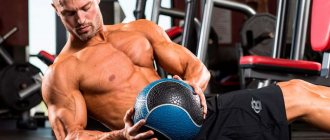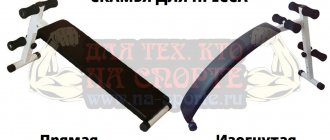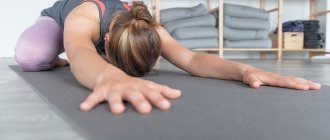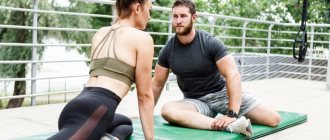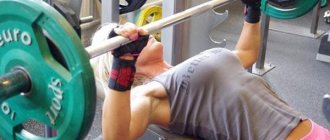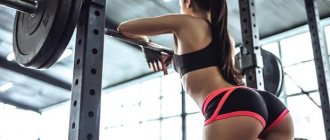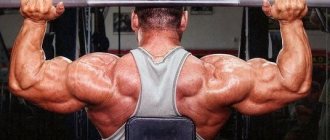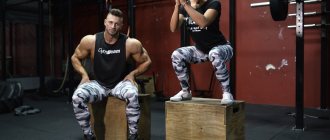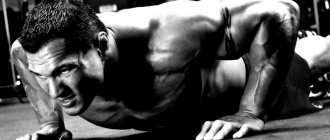What muscles work in the French dumbbell press exercise?
• Main muscle group:
long head of triceps •
Additional group:
forearm muscles •
Type of exercise:
Strength •
Equipment:
Dumbbells •
Difficulty level:
Beginner
Workout Features
The dumbbell curl is easier to do than the barbell French press, as the arms experience less stress. The most important thing is to choose the optimal load so as not to damage the joints.
Triceps are considered a small muscle group; they train it twice a week, no more. The number of repetitions varies from 8 to 12 . You should rest 60 to 90 seconds between sets. It all depends on the specific training goal.
This exercise must be combined with others. Always follow the progression of loads, only then will your muscles actively strengthen. But increase the weights carefully. If you can’t do an exercise with a dumbbell without cheating, then choose a lighter weight.
What muscles are involved?
A bodybuilder who performs the overhead extension technique with the correct technique can count on specific effects:
- triceps works in isolation, other muscles are not included;
- asymmetry in muscle development is eliminated;
- shoulder and elbow stability increases;
- functionality, plasticity and range of hand movements develops;
- easy to do at home.
Carefully! To avoid injury, be sure to warm up before exercising. Our 5 quick hand movements will do just that.
Benefits of sitting and standing exercise
As you may have already noticed, during this exercise the load can be either complex or isolating. It is in isolation that the main advantage of sitting and standing techniques lies. When individual muscle groups are worked, it is easier for you to control the overall load during the week, because you can lose and add in individual exercises.
You can't do that with a pullover. If you choose it, you will need to add or subtract loads from other exercises in order to protect muscle groups.
A complex load on the entire triceps will have a great impact on the appearance of your arms, which not only you, but also other people will be able to notice.
In addition, if you do the exercise in parallel with two dumbbells or with one, but heavy one, you can achieve uniform growth of both arms. This is relevant because many suffer from the fact that their non-working hand usually lags a little behind the other.
Classic option - standing straight
Extension of the arms from behind the head with a dumbbell can be done with one hand or with both. Let's consider the first method:
In the ranking of the TOP 5 exercises for arms with dumbbells, extensions from behind the head take 2nd place.
- Grab the projectile by the top block. To be on the safe side, it is recommended to wrap your thumbs around the bar.
- Feet should be shoulder-width apart. The dumbbell moves up.
- Gently bend your elbows . You need to feel how the muscle fascia stretches.
- There is no need to move your elbows to the sides. Try to keep your shoulders close to your head throughout the entire approach.
- Now, using the triceps, you need to straighten your arms. At the top point, hold for 2 seconds, additionally tensing your muscles.
- Then you do the same for the required number of repetitions.
Note! If the dumbbell weighs a lot, it is recommended to wear an athletic belt.
Don't forget to breathe properly. Now let's see how to do the exercise with one hand:
- Grab the projectile and lift it up. Be sure to turn your palm forward.
- Exhale and bend your arm with the dumbbell, slowly lowering it behind your head.
- Keep your shoulder motionless , only your forearm works.
- You should linger for a couple of moments at the top point and lower your hand. Repeat the movement for the required number of repetitions.
- When you complete the set with your right hand, do the same with your left hand.
See also: 3 types of deadlifts with dumbbells Top 5 best exercises for arms without weights
Errors
•
No warm-up. Performing preparatory exercises can reduce the likelihood of injuries or other damage to the structures of the musculoskeletal system. • Raising your elbows to the sides. In the starting position, the elbows should be directed upward, towards the floor. Inadequate weight.
• The light weight of the dumbbell will not provide the required degree of load on the triceps, and working with heavy equipment will damage the joints and fragile ligaments.
Alternatives
• Parallel press • Close-grip barbell row • Cervical arm extensions • Medicine ball push-ups with a narrow hand position • Back support push-ups
Bench press
This exercise is performed while sitting on a bench. This position perfectly unloads the back. If necessary, replace the EZ dumbbell with a bar.
Algorithm of actions:
- grab the projectile with both hands, wrap your thumb around the bar;
- sit on the bench;
- the dumbbell shoots up;
- the arms are bent at the elbows, the projectile is moved behind the head;
- stretch the muscle fascia, then return to the original position;
- repeat the approach as much as the program requires.
Important! There is also an option without dumbbells. But it is suitable only for people who have reached at least an average level in bodybuilding.
Preparing for the exercise
This movement is rarely performed at the beginning of a workout or as the only one, so warming up is usually done before starting the exercise. If for some reason the exercise comes first in the plan, you should perform 20-30 flexions-extensions in the elbow joint, and rotations in the shoulder joint.
The exercise should not be performed immediately with a working weight. It is necessary to perform 2-3 warm-up approaches if the weight is heavy, or 1-2 if not significant. “Large” is considered to be a weight close to a third of the athlete’s own body weight.
The movement is not recommended to be included in the plan if the athlete cannot safely move the forearm behind the ear.
Lifting dumbbells from behind your head while lying down
Thanks to this exercise, in addition to the long head of the triceps, you can develop the latissimus, serratus anterior and a number of other muscle groups.
We do it with the following technique:
- Lie down on a bench with your feet shoulder-width apart. Place your feet on the floor.
- The head, shoulders and hips need to be pressed to the surface , keep your back straight;
- take the dumbbell with both hands, then lift it above your chest;
- The palms lie on the inner surface of the disc;
- In the initial position, take a deep breath, hold your breath and slowly lower the dumbbell behind your head. Remember to bend your elbows slightly.
- At the lowest point, lift along a similar trajectory. Returning to the starting position, straighten your arms.
Inclusion in the program
The exercise cannot come first in the plan, unless it is an isolated arm workout. If we are talking about chest training, you should first perform bench presses, chest isolating exercises, and work the teres muscle, and only then move on to triceps presses.
Most athletes prefer to first work in strength mode on a bench press or in a triceps push-up rack, and only then “hone” the muscles with high-repetition work.
The exercise is performed both in medium repetition mode, 12-15 repetitions, and in multi-repetition mode. Weights are recommended from light to medium; it may not be worth trying to achieve failure with heavy weights in this exercise.
Important Tips
To achieve maximum effect, be sure to consider the following points:
- During the exercise, concentrate only on the movement of the forearm. Shoulders and elbows should remain stationary.
- It is recommended to lower the dumbbell slowly in order to fully feel the muscle stretch.
- At the bottom, always pause briefly for up to two seconds.
- If the dumbbell has a lot of weight, then you should throw it very carefully so as not to damage the joints.
- Do triceps exercises with a spotter . This will help you concentrate and make the most of the last few reps. They are the ones who perfectly load the muscles and give results. As Stuart McRobert says, it's easy to get off track at the end of a set. That's why an assistant is needed.
- If after training your arms are very sore and cannot be straightened, be sure to find out the reason, it could be an injury.
Dumbbell press or pullover
Pullover is one of Arnold Schwarzenegger's favorite exercises. Its beauty lies in the complex load that affects the triceps, pectoral and even latissimus dorsi muscles. This is the best exercise when working on the upper body, and as you can see, for good reason.
A pullover differs from a regular dumbbell press in the position of the body, due to which the technique changes, along with the working muscle groups.
It is done in a lying position on a bench. While the sitting and standing positions isolate the triceps more during exercise, the pullover allows you to work the major groups of the upper body.
But you have to pay for it. Common sense and caution should be your friends. This is because compound exercises can interfere with other muscle group workouts that they hit along the way.
For example, if you already have a working training program, and you just want to add chest exercises to the work, a pullover can help you, but it can also harm you.
A set of exercises for gaining weight - basic exercises and recommendations for selecting weights for exercisesWe perform squats with dumbbells - a description of the technique of performing the exercise. Subtleties and secrets of squats for girls (125 photos)
The best dumbbell press - advice from professionals and basic variations of the basic exercise (75 photos)
If you're already pushing your triceps or lats to the limit, a pullover can throw a wrench in the works. Overtraining leads to gradual muscle failure, after which you need to recover for a long time and carefully.
Exercise options
The main version of the exercise involves performing a bench press with your right and left hands alternately. This method allows you to work out the target muscles as efficiently as possible.
Two-arm French press
In this case, the exercise is not done with the right and left hands alternately, but with both hands at once. To perform this version of the French press, you can use a dumbbell, holding it vertically in the area of the upper plates, or a barbell with a straight or curved bar.
With this method of performing the bench press, the exercise takes half as much time; this option allows you to work with maximum weights, but for most athletes it will not be very convenient and effective.
Seated French press
The seated press can be performed either on a bench with or without a backrest. The first option is preferable, since in this case the back receives support, this takes the load off the spine and makes it possible to concentrate on working the triceps. However, the load on the spinal column is significantly reduced even when performing bench presses without a backrest
French press standing
An important advantage of this option is a large degree of freedom: you can easily move your body to the right, left, forward and backward to find the optimal position for yourself. However, the same can be done on a bench with an adjustable backrest.
At the same time, when performing the exercise while standing, you have to maintain balance in the chosen position, so it is more difficult to concentrate on working the target muscle.
In addition, as noted above, this option involves a significant load on the spine, which is best avoided if possible.
Contraindications
Many athletes exclude any variations of the French press in order to protect their elbows. This makes sense if we have a strongman who already experiences increased stress on his elbows, but if we are talking about fitness, a couple of approaches with average weight will not critically affect the ligaments of the elbow joint if the athlete performs everything technically correctly.
A complete contraindication to the exercise is any inflammatory processes in the elbows, wrists and shoulders. First you need to heal them, and only then perform isolated exercises with flexion and extension in the joint.
How to pump up triceps at home: training recommendations
To achieve maximum effectiveness in training and eliminate the possibility of injury, you should follow a number of simple tips:
- Be sure to warm up before performing the main group of exercises. Don't ignore the need to prepare your muscles for heavy loads. Pay special attention to the elbow and shoulder joints.
- Concentrate on working on the long head. Start your training with movements that involve raising your arms up.
- Make sure that your elbow joints are in the correct position. In a situation where it is not possible to keep your elbows as close to each other as possible (they move to the sides when loaded), you should choose lighter dumbbells. By reducing the working weight, you will be able to perform the exercise correctly. Forget the erroneous attitude “the heavier the better.” Training with incorrectly selected weights will not bring the desired result and will increase the likelihood of injury to the elbow joints.
- Don't rush, try to work at a measured pace. Your goal is to feel the muscles working during exercise. By slowly raising and lowering the dumbbells, you will be able to place more stress on your triceps.
- The final stage of training is no less important than the starting and main stages. Always finish your workout with stretching exercises. This way, the muscles will be able to fully relax and recover much faster after a heavy load.
